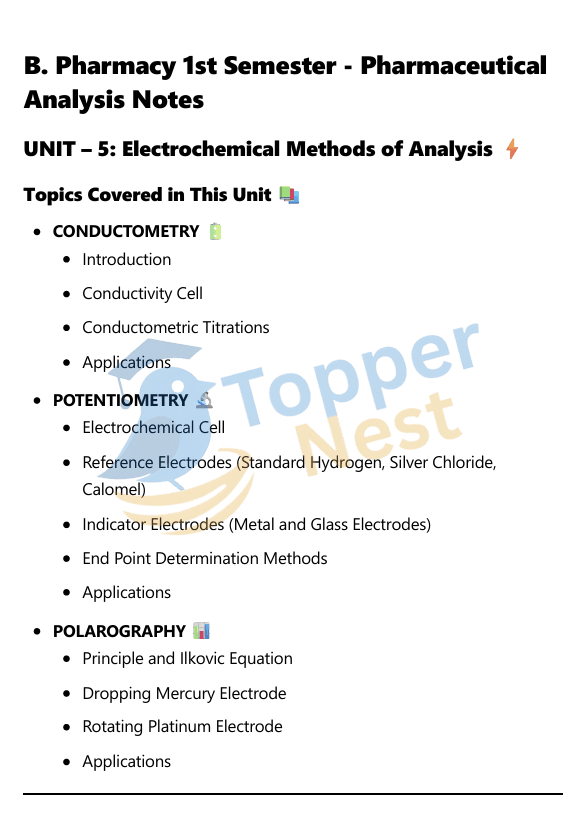Electrochemical methods play a crucial role in pharmaceutical analysis for determining ionic concentrations, redox behavior and drug purity. These methods involve measuring electrical properties like conductivity, potential and current to analyze substances.

What is Conductometry?
Conductometry is an electroanalytical technique that involves the measurement of the electrical conductivity of a solution. This conductivity is directly related to the concentration and mobility of ions present in the solution.
Principle of Conductometry:
The principle of conductometry is based on Ohm’s Law (V=IR), where V is voltage, I is current, and R is resistance. Conductivity (G) is the reciprocal of resistance (G=1/R).
- Ions as Charge Carriers: In solutions, electricity is conducted by the movement of ions. When a voltage is applied across two electrodes immersed in an electrolyte solution, ions migrate towards the oppositely charged electrode, creating an electrical current.
- Factors Affecting Conductivity: The conductivity of a solution depends on several factors:
- Concentration of Ions: Higher concentration of ions generally leads to higher conductivity.
- Mobility of Ions: Smaller ions and ions with lower charge densities tend to move faster, contributing more to conductivity. Hydrogen ions (H+) and hydroxyl ions (OH−) are exceptionally mobile and thus highly conductive.
- Charge of Ions: Ions with higher charges (e.g., Ca2+ vs Na+) contribute more to conductivity.
- Temperature: As temperature increases, the kinetic energy of ions increases, leading to higher mobility and thus higher conductivity. Therefore, temperature control is crucial for accurate measurements.
- Nature of Solvent: The viscosity and dielectric constant of the solvent affect ion mobility.
Definition of Potentiometry
Potentiometry is an electroanalytical chemistry technique that centers on the measurement of the electrical potential (voltage or electromotive force, EMF) generated across an electrochemical cell, with virtually no current flowing through the system. This measured potential is directly related to the concentration (or more accurately, the activity) of specific ions present in the solution being analyzed.
Essentially, potentiometry allows scientists to determine how much of a particular ion is in a solution by measuring the electrical signal it generates.
Core Principle of Potentiometry:
The technique operates on the principles of electrochemistry, particularly the Nernst Equation. An electrochemical cell is constructed, comprising:
- Indicator Electrode: This electrode’s potential is sensitive to the concentration of the analyte ion. Its potential changes proportionally to the logarithm of the analyte’s activity. For instance, a glass electrode specifically responds to hydrogen ion (H+) activity for pH measurements, while other ion-selective electrodes (ISEs) are designed to respond to specific ions like Na+, K+, Cl−, or F−.
- Reference Electrode: This electrode maintains a constant and stable potential, regardless of the changes in the analyte solution. It serves as a benchmark against which the indicator electrode’s potential is compared. Common examples include the Saturated Calomel Electrode (SCE) and the Silver-Silver Chloride Electrode (Ag/AgCl).
- Potential Measurement Device: A high-impedance voltmeter, often called a potentiometer or a pH meter, measures the potential difference between the indicator and reference electrodes. The high impedance is crucial to ensure minimal current flow, preventing disruption of the equilibrium at the electrode surfaces.
What is Polarography?
Polarography is an electroanalytical technique that falls under the broader category of voltammetry. It’s primarily used for the qualitative (identification) and quantitative (concentration determination) analysis of substances that can be oxidized or reduced at an electrode surface.
The defining characteristic of classical polarography, as invented by Nobel laureate Jaroslav Heyrovský in 1922, is the use of a dropping mercury electrode (DME) as the working electrode.
Core Principle of Polarography:
The principle involves applying a linearly increasing voltage (potential) between two electrodes immersed in a solution, and then measuring the resulting current. The solution contains the analyte (the substance of interest) and a supporting electrolyte (a high concentration of an inert salt to ensure that current is carried primarily by the supporting electrolyte, and analyte transport to the electrode is diffusion-controlled).
When the applied potential reaches a certain value, the analyte at the electrode surface undergoes an electrochemical reaction (either oxidation or reduction). This reaction leads to a sudden increase in current.
FAQs on Electrochemical Methods
1. What is the difference between potentiometry and conductometry?
- Potentiometry measures voltage (potential) between two electrodes.
- Conductometry measures conductivity of a solution, i.e., how well it conducts electricity.
2. Why is a glass electrode used in potentiometry?
It is highly sensitive to hydrogen ions, making it ideal for pH measurements in pharmaceutical analysis.
3. What is the role of Ilkovic equation in polarography?
The Ilkovic equation helps in determining the concentration of ions by relating diffusion current to analyte concentration.
4. Which electrode is safer – mercury or platinum?
Platinum electrodes are safer and more environmentally friendly than mercury electrodes, which are toxic and require careful handling.
5. In which cases is conductometric titration preferred?
It is especially useful when visual indicators are unsuitable, like in colored or turbid solutions, and when analyzing weak acid–strong base systems.
